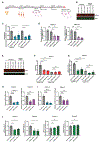The exocyst subunit EXOC2 regulates the toxicity of expanded GGGGCC repeats in C9ORF72-ALS/FTD
- PMID: 38935506
- PMCID: PMC11299523
- DOI: 10.1016/j.celrep.2024.114375
The exocyst subunit EXOC2 regulates the toxicity of expanded GGGGCC repeats in C9ORF72-ALS/FTD
Abstract
GGGGCC (G4C2) repeat expansion in C9ORF72 is the most common genetic cause of amyotrophic lateral sclerosis (ALS) and frontotemporal dementia (FTD). How this genetic mutation leads to neurodegeneration remains largely unknown. Using CRISPR-Cas9 technology, we deleted EXOC2, which encodes an essential exocyst subunit, in induced pluripotent stem cells (iPSCs) derived from C9ORF72-ALS/FTD patients. These cells are viable owing to the presence of truncated EXOC2, suggesting that exocyst function is partially maintained. Several disease-relevant cellular phenotypes in C9ORF72 iPSC-derived motor neurons are rescued due to, surprisingly, the decreased levels of dipeptide repeat (DPR) proteins and expanded G4C2 repeats-containing RNA. The treatment of fully differentiated C9ORF72 neurons with EXOC2 antisense oligonucleotides also decreases expanded G4C2 repeats-containing RNA and partially rescued disease phenotypes. These results indicate that EXOC2 directly or indirectly regulates the level of G4C2 repeats-containing RNA, making it a potential therapeutic target in C9ORF72-ALS/FTD.
Keywords: ALS; ASO; C9ORF72; CP: Cell biology; CP: Neuroscience; DPR; FTD; exocyst; iPSC; neurodegeneration; neuron; poly(GR).
Copyright © 2024 The Author(s). Published by Elsevier Inc. All rights reserved.
Conflict of interest statement
Declaration of interests The authors declare no competing interests.
Figures




References
-
- DeJesus-Hernandez M, Mackenzie IR, Boeve BF, Boxer AL, Baker M, Rutherford NJ, Nicholson AM, Finch NA, Flynn H, Adamson J, et al. (2011). Expanded GGGGCC hexanucleotide repeat in noncoding region of C9ORF72 causes chromosome 9p-linked FTD and ALS. Neuron 72, 245–256. 10.1016/j.neuron.2011.09.011. - DOI - PMC - PubMed
-
- Renton AE, Majounie E, Waite A, Simón-Sánchez J, Rollinson S, Gibbs JR, Schymick JC, Laaksovirta H, van Swieten JC, Myllykangas L, et al. (2011).A hexanucleotide repeat expansion in C9ORF72 is the cause of chromosome 9p21-linked ALS-FTD. Neuron 72, 257–268. 10.1016/j.neuron.2011.09.010. - DOI - PMC - PubMed
Publication types
MeSH terms
Substances
Supplementary concepts
Grants and funding
LinkOut - more resources
Full Text Sources
Medical
Molecular Biology Databases
Miscellaneous

